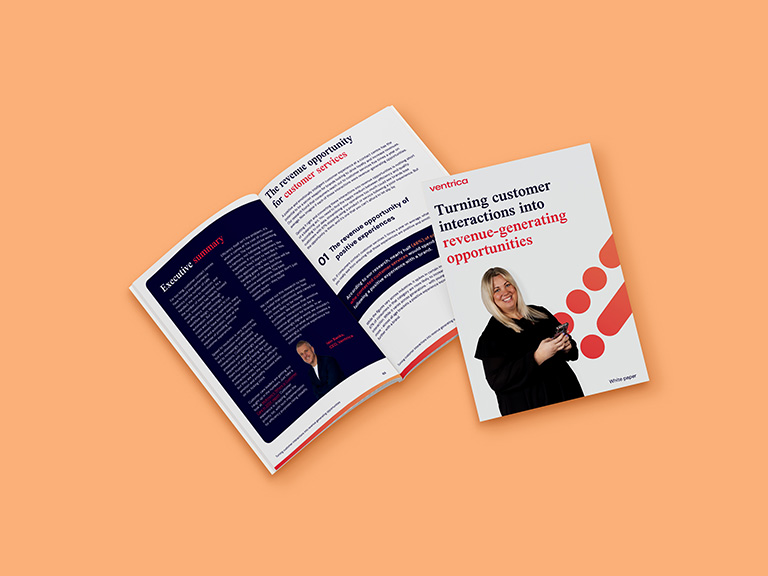10 steps to build customer retention for your brand
Customer retention is a hot topic in 2025. But how to you ensure customers buy from you again and again? Where are the right places to invest?
- Insights, blogs & articles
Customer retention gets a lot of attention. There are entire strategies built around it – CRM workflows, loyalty programmes, reactivation campaigns, referral schemes. And yet many of the brands investing heavily in retention still see poor results. Customers leave, repeat purchase rates stay flat, lifetime value won’t move.
Most retention strategies treat customer retention as a downstream variable. They start after the purchase, and then follow a linear playbook – offer an incentive, track engagement, set reminders, repeat. But retention doesn’t play out like that in real life. It’s shaped by what happens in between – especially when something goes wrong. For example – if a delivery is late and nobody follows up, or if a customer has to chase support five times for the same issue.
These are the moments that aren’t logged as churn in the CRM. They’re not flagged by your net promoter score. But they’re the reason many customers won’t come back – even if the product itself was good. And yet in most cases, service teams are rarely positioned as part of the retention strategy. At Ventrica, we think they should be.
Why customers really leave
A customer’s decision not to buy from you again is rarely made at the moment of churn. In most cases this decision is made much, much earlier – during a frustrating support exchange, or a period of post-sale silence where the customer started to disengage. These moments don’t always register with brands as dissatisfaction. They don’t always prompt a complaint. But they begin to shift the relationship from trust to uncertainty.
Many brands assume customers leave because of pricing, competition or product fit. These factors are important – but they are rarely the deciding factor. What actually causes churn more often than not is an erosion of confidence. Not through one major failure, but through a sequence of unresolved or mishandled interactions.
That erosion often goes unnoticed because it doesn’t look like dissatisfaction in a dashboard. The customer may say nothing. They may even appear to be engaged – opening emails, browsing the website, responding to surveys. But behind that, something has shifted. They no longer expect to be impressed, they no longer expect things to be easy. They no longer believe the brand will take ownership where it matters.
And this is where most retention strategies fall short. They respond to churn after the fact, rather than addressing the quiet signals that lead up to it. And because those signals live in conversations, not reports, they’re usually missed by the teams tasked with solving the problem.
But how do you build meaningful retention? What does it really mean for a customer to stay? Fundamentally, it has nothing to do with habit or convenience – it’s about whether the last experience you gave the customer gave them a reason to return.

10 proven ways you can improve your customer retention right away
We’re not looking at surface-level tips here – we’re trying to show you what actually moves the needle operationally. You can implement any one of these and see an increase in retention if you do it properly.
1. Get onboarding right, every time
Customers form strong first impressions fast. Poor onboarding creates regret and confusion – and often, a dependency on customer support. Focus on clear expectations, accessible help (self-serve if you can) and proactive reassurance in the first few days or weeks.
2. Resolve issues quickly – but make sure you close the loop
Speed matters – but not as much as finality. Customers lose confidence when they have to follow up. Track first contact resolution (FCR), but also ensure your agents take ownership until the issue is fully closed – even if it spans multiple channels.
3. Identify early signs of disengagement
Look for patterns – repeated support contacts, long time-to-resolution, even passive CSAT scores. These are, when interpreted correctly, often precursors to churn – not just noise. Most brands miss these signals because they don’t monitor them in context.
4. Proactively check in with high-friction customers
If someone has had a bad experience, follow up – even after it’s been resolved. A simple message acknowledging the issue and confirming that it’s now been addressed properly can significantly change how that customer feels about staying.
5. Give your support team more autonomy
Customers notice when frontline staff are empowered to help – and when they’re just passing the issue on. Faster, more empathetic service depends on frontline teams having the systems and authority to actually fix things.
6. Ask for feedback; and show you act on it
People want to feel heard. But more importantly, they want to see that what they say has an impact. Follow up on common themes, and build in simple ways to close the feedback loop with “you said, we did” visibility.
7. Reduce the effort required to get help
Retention is about making things easy. Customer effort is one of the clearest predictors of loyalty. Review your escalation processes, authentication steps and transitions between channels to remove any unnecessary friction.
8. Reward loyalty in the ways that feel personal
Go beyond points and perks. A loyalty strategy should reflect customer history and not just spend. Use milestones, preferences, past support interactions and any other data you have to create moments of recognition that feel earned.
9. Build a rhythm of relevant, post-sale communication
Silence erodes trust. Keep customers informed even when there’s nothing wrong – delivery updates, usage tips, upcoming changes. This builds a sense of presence, and helps customers feel supported without them having to ask.
10. Train your teams on empathy
Support staff often know the system inside and out, but retention comes from how a conversation feels and not just whether it’s correct. Emotionally intelligent service (what we call emotive CX) is one of the biggest differentiators in experience and in loyalty.
How you can ensure your service operation is built to retain
If you want to improve retention, you need to build a service operation that is structurally capable of holding onto customers – especially under pressure. That means systems, tooling, processes and culture all need to align around a single goal: preserving confidence at every stage of the post-sale experience.
There are a few core principles that you need to be aware of to underpin a retention-capable operation.
Empower your frontline team to resolve, not just respond
Frontline staff are often the only human point of contact a customer will have. But in many service environments, they are restricted by limited authority and rigid scripts. To drive retention, support teams need the ability – and the permission – to take ownership of issues, escalate when necessary and follow up properly. If the agent handling the problem isn’t allowed to do what’s needed to solve it, you create churn risk by design.
Build context into every interaction
Customers expect you to remember them. Not just who they are, but what’s happened already. That means surfacing interaction history, preferences, past issues and open orders in real time. Without that context, customers have to repeat themselves, and support teams can’t tailor their responses – which leads to churn. Context is what turns a one-off resolution into a loyalty-building moment.
Design your SLAs around outcomes, not activity
Most service operations measure success by speed – time to respond, time to close, chats per hour, etc. Retention is shaped by the quality of the resolution, not just the speed of the reply. Rethinking your SLAs around customer outcomes – such as first time resolution accuracy, sentiment improvement or follow up completion – gives your team space to act in ways that build trust, not just hit volume targets.
Integrate service into your retention strategy – not after it
Retention plans often live with marketing, digital or commercial teams, disconnected from service delivery. But service owns the key post-purchase moments where retention is either reinforced or lost. Service leaders should have a seat at the table when retention targets are set – and the operation should be resourced accordingly. You can’t expect your team to drive loyalty if they’re excluded from the strategy that defines it.

How Ventrica can help you boost customer loyalty and reduce churn
At Ventrica we design and operate service functions that help brands retain customers at scale. That means building support operations that actively rebuild confidence and close the loop properly.
We work with clients across retail, D2C, financial services, healthcare and regulated sectors – where retention is high-stakes, journeys are complex, and in many cases, post-sale experience is the weak point. Our role isn’t limited to providing agents – we help design, operate and scale service environments that are structurally capable of holding onto customers, even when things go wrong.
We build retention into day-to-day service delivery
Most in-house teams are focused on volumes and SLAs. We help you go further – embedding practices like churn risk tagging and friction signal escalation directly into the agent workflow. This ensures that customer confidence is the operational goal.
We give your frontline team the tools and the training to act
We equip your teams with the context and discretion to make decisions that reduce churn – such as personalised reassurance after a complaint or proactive outreach after a delay. And – we track outcomes at the customer level, not just the ticket.
We identify and act on churn signals early
Using sentiment monitoring, interaction patterns, repeat contact flags and qualitative feedback, we help spot the kinds of early warning signs that don’t show up in your CRM – and then act on them. This might mean a recovery email, a callback from the same agent, or a fast-track escalation to prevent churn.
We help close the gap between service and commercial outcomes
Many businesses invest heavily in acquisition and retention marketing – but the service layer is disconnected. We align your support with your commercial priorities, allowing us to share customer insight back into your business and linking service performance to real business outcomes like LTV and loyalty programme engagement.
We can scale from overflow to full-service design and delivery
Whether you’re looking to strengthen an in-house team or fully outsource post-sale experience, we can flex around your operation. Our team integrates directly with your systems and workflows, and our support hubs ensure quality and cultural alignment from day one.
If your retention strategy is underdelivering, and your service team is underresourced or misaligned, we can help you fix it properly. Not with another layer of automation or AI, but with a customer experience operation that earns confidence, reduces attrition and holds onto the customers your brand has worked hard to acquire.
If this sounds like something your brand needs, let’s talk.
Frequently asked questions (FAQs)
What are the 3 R’s of customer loyalty and retention?
The 3 R’s of customer loyalty and retention are:
Rewards – incentivising repeat behaviour through perks, points or benefits. But for true loyalty, these rewards must feel meaningful and earned, not just transactional.
Relevance – tailoring offers, communication and experiences to individual customer needs. Personalised service builds emotional loyalty, not just repeat custom.
Recognition – acknowledging loyalty in ways that matter – remembering preferences, offering exclusives or simply treating returning customers with respect and familiarity.
These principles shift the focus from just keeping customers to valuing them – which is a critical difference in retention.
How do you promote customer loyalty?
Customer loyalty is earned through consistency. You promote it by showing up when it matters. When customers feel understood and supported, they are much more likely to stay – so promoting customer loyalty means following up after problems, acting on feedback, offering personalised communication and making every interaction feel like it matters.
How do you keep customers coming back?
You keep customers coming back by building trust. That trust is shaped by how you respond when things go wrong, how easy it is to get help, and whether you follow through. A strong post-sale experience – clear onboarding, proactive updates, thoughtful service – reminds customers they’ll be looked after if they stay.
What is the 80/20 rule in customer retention?
The 80/20 rule suggests that 80% of your revenue comes from 20% of your customers. In retention terms that means that your most valuable customers deserve the most attention. A well-run loyalty or service programme should focus on protecting this group – because losing them has a far greater financial impact than general churn.
What’s the primary KPI I should be using to measure customer retention?
By far the most important KPI is customer retention rate – CRR. It tells you how many customers you’ve kept over a specific period, excluding new customer acquisition. It’s a clear indicator of how well your experience holds up over time. Other useful metrics such as Customer Lifetime Value and Repeat Purchase Rate – should support, not replace CRR.

Adam Clark
CX Solutions Consultant
Let’s take the guesswork out of your CX performance
Book your free Zendesk health check and get expert, honest insight – no obligation, no pressure.
